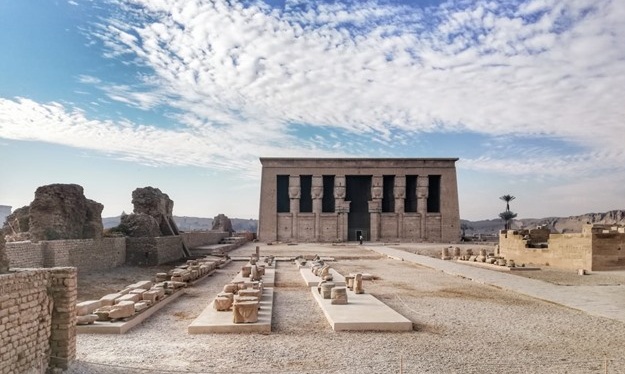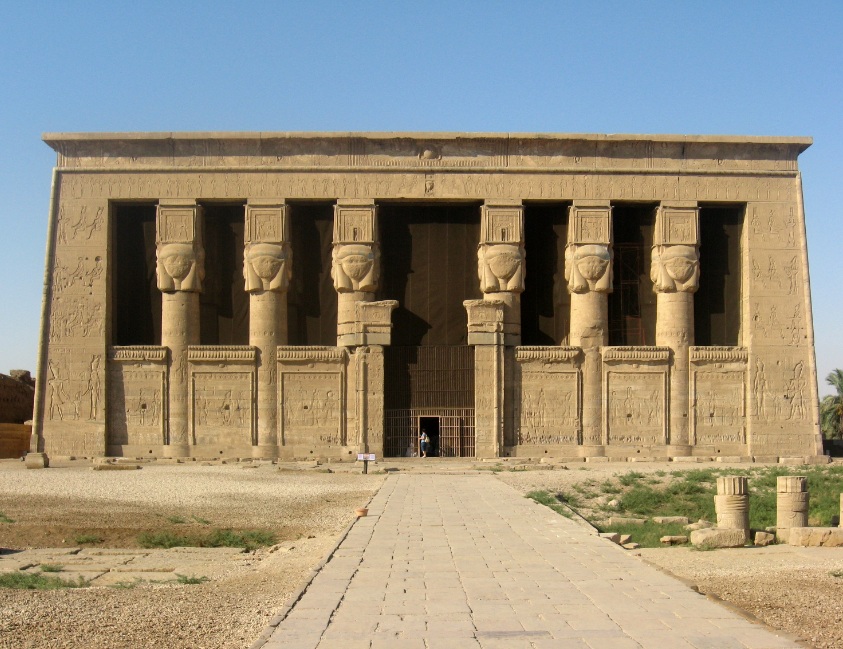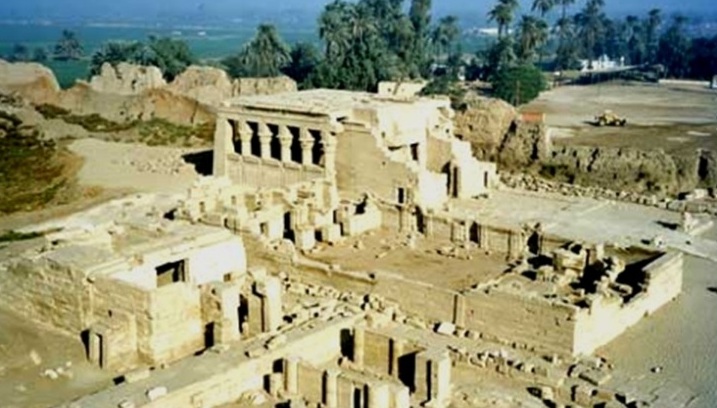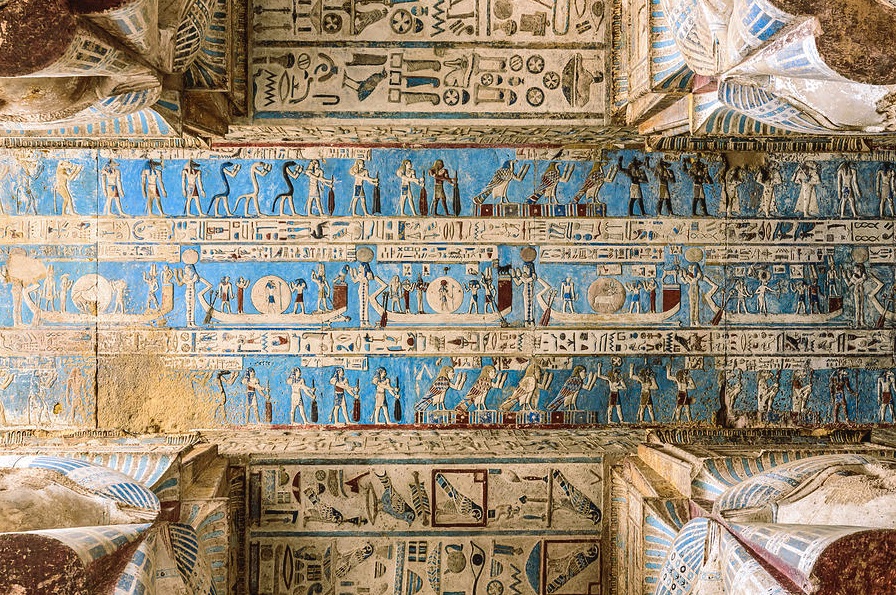Dendera Temple | Temple of Hathor, Qena, Egypt
On the west bank of the Nile River, near the city of Qena, stands one of the most mesmerizing and best-preserved temples in all of Egypt — the Temple of Dendera, also known as the Temple of Hathor. This sacred sanctuary is a radiant example of Egypt’s artistic brilliance and enduring spirituality, where every wall, ceiling, and column seems alive with divine stories carved over two millennia ago.
Dedicated to Hathor, the goddess of love, beauty, joy, fertility, and music, the Temple of Dendera is a masterpiece that bridges the pharaonic and Greco-Roman worlds. Its walls still shimmer with color, its hieroglyphs remain sharp and vibrant, and its spirit continues to captivate every traveler who steps inside.
For those seeking a deeper connection with ancient Egyptian mythology, astronomy, and sacred architecture, Dendera Temple offers a journey through time — one that blends art, science, and devotion in perfect harmony.
The Divine Goddess Hathor: Heart of Dendera
To truly appreciate the Temple of Dendera, one must first understand its divine purpose — it was built for Hathor, one of Egypt’s most beloved deities. Often depicted as a woman with a cow’s ears or as a cow herself, Hathor represented motherhood, love, joy, and the nurturing energy of the sun.
She was the protector of women, the goddess of music and dance, and the celestial mother who welcomed souls into the afterlife. To her followers, Hathor was the source of comfort, happiness, and harmony.
The ancient Egyptians considered Dendera her earthly home. Pilgrims traveled from across Egypt to celebrate festivals here, particularly the Feast of the Beautiful Reunion, when Hathor was believed to travel by boat from Dendera to Edfu Temple to reunite with her divine consort, Horus. This symbolic voyage represented the eternal cycle of love, fertility, and cosmic balance.
The Origins and Construction of Dendera Temple
While the current temple complex dates mainly from the Ptolemaic and Roman periods (c. 125 BC – AD 60), the site of Dendera had been sacred for much longer — at least since the Old Kingdom (around 2600 BC). Early rulers, including Pepi I and Thutmose III, left evidence of earlier shrines dedicated to Hathor.
The temple we see today was begun under Ptolemy XII (the father of Cleopatra VII) and completed during the Roman reign of Emperor Tiberius. Despite being built under foreign rule, the design and decoration strictly followed traditional Egyptian temple architecture, symbolizing continuity and reverence for the old religion.
Over centuries, the temple complex expanded into a sprawling sacred site covering more than 40,000 square meters, with sanctuaries, chapels, courtyards, and birth houses, each serving a unique spiritual purpose.

Architectural Grandeur: Harmony in Stone
The Temple of Dendera is one of the best-preserved structures in Egypt, thanks to its later construction and the protective sands that buried it for centuries. When you enter its grand façade, you are greeted by six massive columns, each crowned with the face of Hathor herself — serene, smiling, and crowned with cow ears and a sistrum (a musical instrument sacred to her).
1. The Hypostyle Hall
The main hall, known as the Hypostyle Hall, is one of the most breathtaking interiors in Egypt. It contains 24 towering columns, each nearly 15 meters high, supporting a vast ceiling covered in astronomical scenes.
These painted ceilings depict celestial maps, the goddess Nut (the sky goddess) swallowing the sun at sunset and giving birth to it at dawn, and vibrant constellations — a cosmic calendar for priests and astronomers.
Many colors are still visible today — vivid blues, golds, and reds — revealing how ancient temples once glowed with life and energy. Restoration projects have recently cleaned much of the soot and dirt, allowing the original brilliance to shine again.
2. The Sanctuary of Hathor
At the heart of the temple lies the Sanctuary of Hathor, where the goddess’s sacred statue once rested in a gilded shrine. Only priests were allowed to enter this inner sanctum, where daily rituals were performed to awaken and honor the goddess’s divine spirit.
Surrounding the sanctuary are side chapels dedicated to other deities, including Osiris, Isis, and Horus, emphasizing Dendera’s connection to the larger pantheon of Egyptian gods.
3. The Roof and the Zodiac
Climbing the temple’s staircase leads to one of its most famous features — the Dendera Zodiac. Originally carved on the ceiling of a chapel on the roof, this circular zodiac represents the ancient Egyptian understanding of the stars, planets, and constellations.
The original zodiac is now housed in the Louvre Museum in Paris, but a replica remains in place. It’s an extraordinary depiction of how ancient Egyptians connected astronomy to spirituality, showing the twelve zodiac signs alongside Egyptian deities and celestial symbols.
From the rooftop, visitors can also enjoy panoramic views of the surrounding desert and the lush Nile Valley — a reminder of the temple’s timeless harmony between earth and sky.
The Crypts: Secrets Beneath the Temple
One of Dendera Temple’s most intriguing features lies below — its crypts, narrow underground chambers carved into the temple walls and floors. These mysterious spaces were used to store sacred objects, ritual equipment, and religious texts.
Inscriptions and carvings inside these crypts depict scenes of divine mysteries, including the Dendera Light Relief — a controversial carving that some claim shows an ancient form of electricity, though scholars interpret it as a symbolic image of creation and rebirth.
Regardless of interpretation, the crypts reveal the Egyptians’ deep devotion to sacred symbolism and their mastery of hidden architectural design.

Mythology and Symbolism of Dendera
Dendera was not just a temple — it was a cosmic map, a representation of the universe in stone. Every wall and chamber was filled with mythological meaning.
Hathor, as the goddess of joy and life, was associated with the sky and the Milky Way, often represented as a celestial cow giving birth to the sun each morning. The temple’s alignment with the stars and its astronomical ceiling confirm its role as a spiritual observatory — a place where the heavens and earth met.
The temple also symbolized the cycle of creation. Its ceilings represented the sky, the floors symbolized the earth, and the crypts below stood for the underworld. Priests believed that performing rituals here maintained balance between these realms, ensuring the continued harmony of the universe.
The Birth House (Mammisi)
Adjacent to the main temple stands the Birth House, known as the Mammisi, a small yet beautifully decorated structure celebrating the divine birth of Horus, the son of Hathor and Horus the Elder.
Inside, reliefs depict scenes of childbirth, divine nursing, and the presentation of the newborn god. This structure emphasized the importance of motherhood and rebirth — central themes in Hathor’s worship.
The Birth House also played a vital role during the Beautiful Reunion Festival, symbolizing the regeneration of life and the renewal of cosmic order.
Roman and Christian Influence
Even after the Roman conquest, Dendera continued to flourish as a religious center. Roman emperors, including Augustus and Tiberius, added inscriptions and decorations to the temple in traditional Egyptian style — a testament to how deeply respected Egypt’s sacred traditions were, even by foreign rulers.
During the Christian period, parts of the temple were converted into a church, and some images of the gods were defaced, yet much of the structure remained intact. Ironically, this transformation helped preserve the temple, as it continued to be used rather than abandoned.
Today, Dendera stands as a remarkable blend of Egyptian, Greek, and Roman influences — a cultural bridge uniting three great civilizations.

Rediscovery and Preservation
For centuries, Dendera Temple lay buried beneath sand and debris until it was rediscovered in the 19th century. French scholars and travelers, including those from Napoleon’s expedition (1798–1801), documented the site in their monumental Description de l’Égypte.
Their work revealed the temple’s exceptional preservation and intricate artwork, sparking worldwide admiration. In modern times, restoration efforts by the Egyptian Ministry of Tourism and Antiquities have carefully cleaned and stabilized the temple, removing centuries of soot and grime to reveal its original colors.
Today, Dendera is a jewel of Egypt’s archaeological heritage — a rare place where visitors can still see how vividly painted and alive ancient temples once were.
Visiting Dendera Temple Today
???? Location:
The Temple of Dendera is located near Qena, about 60 km north of Luxor, on the west bank of the Nile River.
???? Opening Hours:
Open daily from 8:00 AM to 5:00 PM.
???? Ticket Prices (as of 2025):
-
General Admission: Approx. 200 EGP for adults
-
Student Discount: 100 EGP
???? Getting There:
Visitors can reach Dendera easily from Luxor by taxi, private car, or organized day tour. The drive takes around 1 hour, passing through scenic countryside and small Nile-side villages.
???? Tips for Visitors:
-
Visit early morning or late afternoon to avoid heat and crowds.
-
Bring water, sunscreen, and comfortable shoes — the site is expansive.
-
Don’t miss exploring the roof for panoramic views and the replica Zodiac.
-
Take time to observe the colors on the ceiling — they are among the best preserved in Egypt.
Nearby Attractions
While in the area, visitors can combine Dendera with other remarkable Upper Egyptian sites:
-
????️ Abydos Temple: Dedicated to Osiris, located about 70 km north, it’s one of Egypt’s holiest sites.
-
???? Luxor: Home to the Valley of the Kings, Luxor Temple, and Karnak Temple — just an hour away.
-
???? Qena City: A charming Nile city known for its traditional crafts and bustling local markets.
These destinations together offer a deeper exploration of Egypt’s spiritual geography — where gods, kings, and cosmic forces once intertwined.
Dendera in Astronomy and Science
The Temple of Dendera has long fascinated historians of science. Its zodiac and astronomical ceilings show that the ancient Egyptians possessed advanced knowledge of celestial cycles.
They tracked the movements of stars and planets, predicting events like the flooding of the Nile — the foundation of Egypt’s prosperity. Hathor herself was linked with Venus, the morning and evening star, symbolizing love and renewal.
These depictions reveal how seamlessly the Egyptians integrated mythology, science, and spirituality into their worldview. The temple was both a house of worship and an ancient observatory — a place where priests studied the heavens to maintain cosmic order.
The Spiritual Experience of Dendera
What makes Dendera so special is not only its preservation but the feeling it evokes. Inside, shafts of sunlight filter through the massive columns, illuminating sacred images that have survived untouched for millennia. The air feels heavy with reverence, as if Hathor herself still resides within the temple walls.
Many visitors describe a sense of calm and harmony here — fitting for a temple dedicated to the goddess of love and joy. The music of the past seems to echo silently through its halls, inviting you to pause, breathe, and connect with the divine.
Preservation Efforts and Challenges
Like many ancient monuments, Dendera faces environmental challenges — including humidity, temperature fluctuations, and groundwater. Conservation teams are working continuously to stabilize the structure and preserve its vivid reliefs.
Modern technology, including 3D laser scanning and digital mapping, helps document the temple’s details for future generations. Ongoing collaborations between Egyptian and international archaeologists ensure that Dendera will remain one of the world’s most pristine examples of pharaonic art and architecture.
Conclusion: The Eternal Light of Hathor
As the sun sets over the Nile, the Temple of Dendera glows softly in the golden light, its ancient walls casting long shadows across the sand. Standing before it, you can feel the presence of Hathor — the goddess of love, music, and beauty — whose spirit still radiates from every stone.
The temple is not just a monument; it is a song carved in stone, a cosmic dance between heaven and earth, a living reminder of how deeply the ancient Egyptians understood harmony, joy, and renewal.
Visit Dendera Temple — explore the home of Hathor, marvel at its celestial art, and feel the divine energy of one of Egypt’s most enchanting temples today!


